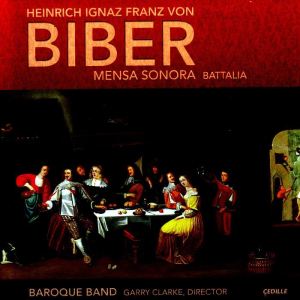 |
 |
|


alternatively
CD: MDT
AmazonUK
AmazonUS
Sound
Samples & Downloads
|
Heinrich Ignaz
Franz VON BIBER (1644 - 1704)
Mensa Sonora, Battalia
Pars I in D [8:42]
Pars II in F [6:10]
Pars III in a minor [7:53]
Pars IV in B flat [8:57]
Pars V in E [6:16]
Pars VI in g minor [9:22]
Battalia in D* [8:49]
 Baroque Band/Garry Clarke
Baroque Band/Garry Clarke
rec. 9-10 June 2008, 9 November 2009*, Nichols Hall, Music Institute
of Chicago, Evanston, Ill., USA. DDD
 CEDILLE RECORDS CDR90000116 [56:50]
CEDILLE RECORDS CDR90000116 [56:50] 
|
|
|
The music of Heinrich Ignaz Franz von Biber is quite popular
among string ensembles and violinists, as the number of recordings
in the catalogue proves. That is understandable: his music is
brilliant and technically demanding, but also of considerable
depth. This collection is a bit different. It’s basically
musical entertainment, and less virtuosic than most music by
Biber. That probably is the main reason these pieces are not
often performed and recorded.
In 1670 Biber entered the service of Prince-Archbishop Maximilian
Gandolph von Khüenburg. To him Biber dedicated his famous
Mystery Sonatas of 1676. But he also composed the collection
Mensa sonora, meaning "sounding table". This is music
to be played during dinner, and that explains why it is technically
not very complicated. The use of the scordatura technique,
for instance, which is so prominent is Biber's oeuvre, is completely
absent here. In his dedication to the Prince-Archbishop Biber
points out: "The Sonorous Table, or Instrumental Table Music
with the lively sound of the violin [is] by no means painstakingly
to spread upon your princely table a rare banquet, like those
of the glutton Apicius, nor to serve you with a pearl beyond
price, like the spendthrift Cleopatra, but to tender in all
dutifulness the noble jewel of homophony, concordant with obedient
and humble veneration''.
The collection consists of six suites, each called Pars,
with five to seven movements. Pars I, IV and VI begin with a
sonata and end with a sonatina, Pars II and V
open with an intrada. As with most baroque suites they
contain dances such as allemande, courante and sarabande. But
there is little French in these suites; they lean much more
on the Italian style. In addition there are movements like balletto,
aria, trezza and retirada - the latter typical of music of the
South-German/Austrian region. Pars III and VI also include a
ciacona.
The scoring is violin, two violas and bass. These suites are
mostly played with one instrument per part, but Garry Clarke
argues that they can be played by a larger ensemble which is
exactly what the Baroque Band is doing here. It plays with nine
violins, two violas, two cellos, bass and harpsichord. I find
this practice questionable and the arguments in its favour not
very convincing. One of them is that when a larger band is playing
there is a chance that the archbishop may have heard "at least
some of the music over the din of the meal". This suggests the
music was played while the archbishop and his guests were eating,
but it is equally possible - and maybe even more likely - that
the music was played between the various courses of the meal.
In addition, the fact that Biber has written just one violin
part and two viola parts suggests that the violin was to be
played by a soloist. This is supported by the dedication just
quoted in which Biber refers to 'violin'. In this recording
the proportion between the violin part and the two viola parts
has been turned upside down. Musically the performance with
a larger ensemble is also unsatisfying. The various episodes
in the rather short dances have to be repeated. The repeats
require ornamentation, but in a performance with a large ensemble
that is impossible.
That is one of the reasons these performances are not very compelling.
And I am being polite. Biber is one of my favourite composers,
and I never miss a chance to hear a new recording of his music.
But I was bored to death while listening to these suites. Some
movements come off relatively well, in particular some balletti.
But in general the string playing is not very colourful and
dynamically too flat. This music needs a truly speech-like and
gestural interpretation, and that is what is missing here.
In addition we hear one of Biber's most famous pictorial compositions,
the Battalia in D. In eight movements Biber depicts a
battle, and he has given precise instructions in regard to the
interpretation. Even this piece isn't really engaging. The various
effects Biber has included are rather lame. Playing a long note
at the end of the seventh movement, The Battle, is simply a
misjudgement. And in the last movement the dissonant notes expressing
the lament of the wounded soldiers are too feeble.
If you want a really good performance of Biber's Mensa sonora,
look for the recording of Musica Antiqua Köln (Archiv),
which should still be available. On another disc they also have
recorded the Battalia.
Johan van Veen
|
|
|

